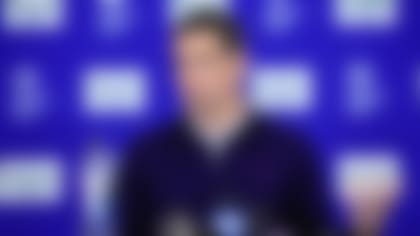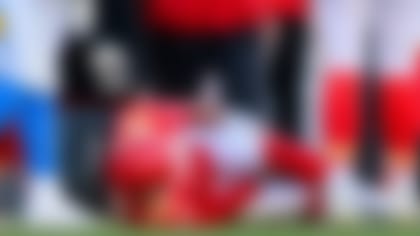So you passed on that extra hamburger or hot dog during the Memorial Day cookout. Maybe you didn't take that second (or third) scoop of macaroni salad or slice of pie, either.
All it took was standing on the scale or in front of the mirror to convince you that the time had come to do something about your weight. That is, something other than add to the strain on your clothing.
But things are a little different in the NFL.
Every offseason brings its share of players addressing weight issues in an effort to enhance their performance, and in many cases the goal is to actually gain rather than lose.
The following list is of players who fall into both categories this offseason:
Amobi Okoye, DT, Houston Texans
The goal: As he told the Houston Chronicle, to "lose a few pounds." It turned out he dropped a whopping 32 by following a rigorous conditioning program. The 6-foot-2 Okoye has gone from 315 to 283 pounds.
The purpose: Increase his speed so that he is a more effective pass rusher. Okoye figured the drastic weight loss was necessary for him to get back to the player he was as a rookie in 2007, when he had 5½ sacks. Since then, he has had a mere 2½. The Texans aren't alarmed by Okoye's dramatic weight loss, although they don't want him getting so light that offensive linemen are able to handle him too easily. (Other members of the Texans' defensive line have had far more modest weight loss: End Antonio Smith, 13 pounds; end Mario Williams, 10, and tackle Shaun Cody, four).
William Hayes, DE, Tennessee Titans
The goal: Add 20-plus pounds, which he has done. The 6-3 Hayes has gone from 255 to 278 pounds.
The purpose: Improve his ability to stop the run and become a more effective bull-rusher. Hayes feels much stronger than he did last season when he was credited with 51 tackles and had four sacks.
Jovan Haye, DT, Tennessee Titans
The goal: Lose 25 pounds, which he has done through diet and exercise. The 6-2 Haye has gone from about 300 to 275 pounds.
The purpose: Increase his play-making ability. When the Titans signed Haye as a free agent from Tampa Bay last year, he said he was advised to get heavier. The team apparently thought that would improve his chances of helping to fill the massive void created by the free-agent departure of Albert Haynesworth. Instead, it made Haye less explosive and hurt his endurance. He was credited with 32 tackles and had a half sack while part of a rotation at defensive tackle.
Marcus Stroud, DE, Buffalo Bills
The goal: At the end of the 2009 season, he told reporters of his intention to enter the 2010 campaign in the best shape of his life. At 300 pounds, the 6-6 Stroud is nearly 20 pounds lighter than he was last season.
The purpose: When the '09 season ended, Stroud's biggest concern was trying to avoid another year of being slowed by nagging knee, ankle and back problems. With the Bills defense switching from a 4-3 to a 3-4 under new coach Chan Gailey, Stroud is moving from tackle to end and needs to be lighter to help his speed when rushing the passer.
Tackling weight issues
Eagles guard Max Jean-Gilles went with a trendy surgical procedure to tackle his weight issues. Steve Wyche wonders if other players will follow this player's lead. **More ...**
Max Jean-Gilles, G, Philadelphia Eagles
The goal: To reduce his 6-3 frame by 68 pounds. Since undergoing lap-band surgery last April, he has dropped 30 pounds, going from 388 to 358. Jean-Gilles is striving for 320, although he told reporters that his doctor informed him that a healthy weight for him would be 270.
The purpose: Avoid the health dangers that go with tipping the scales at nearly 400 pounds. Jean-Gilles had complained of a shortness of breath and chest pains before deciding that he desperately needed to shed the weight. (In contrast, there is 6-9 Eagles reserve offensive tackle King Dunlap, who was told by coaches that the 305 pounds he was carrying weren't quite enough to allow him to handle the challenges presented by larger and stronger defensive linemen. Now, he is 335 pounds.)
Paul Kruger, DE, Baltimore Ravens
The goal: To gain about 15 pounds, which he has. The 6-5 Kruger has gone from 260 to 275 pounds.
The purpose: Have sufficient bulk and strength to handle the transition from outside linebacker, which he played as a rookie last year, to defensive end. Kruger had little impact in '09 beyond an interception return that helped the Ravens beat the Pittsburgh Steelers in overtime. The Ravens want to see what he can do in a role that will require him to do more to help others make plays.
Pat White, QB, Miami Dolphins
The goal: To get bigger. Since his rookie season in '09, White has added 18 pounds.
The purpose: When White joined the Dolphins last year, he was 6 feet and 190 pounds. Although he was a reserve, his body didn't have enough cushion to consistently withstand the punishment he would take when taking snaps in the "Wildcat." It does now, and coach Tony Sparano has gone out of his way to gush about White's offseason work. Some have speculated that the motivation came from a particularly hard hit that White took against Pittsburgh. In 13 games, he carried 21 times for 81 yards.
Quarterback market rumblings
There are rumblings throughout the league that at least one and possibly two quarterbacks could be on the move before the start of the season.
One name that constantly surfaces is Michael Vick, who is backing up Kevin Kolb in Philadelphia. Although the Eagles have given Vick a $1.5-million payment he was due to receive in the offseason, that would not necessarily rule out the possibility of their trading him to a team desperate for quarterback help (such as the Bills) and then re-acquiring Jeff Garcia as an experienced understudy to Kolb.
Another name is the Dolphins' White. There some people in the NFL who interpret Sparano's praise of White's offseason work as an attempt to drum up interest in him for a trade, especially with the Dolphins already carrying three other quarterbacks: Chad Henne, Chad Pennington and Tyler Thigpen.
In addition, there is persistent buzz about the Arizona Cardinals being so unhappy with Matt Leinart's offseason that they would like Kurt Warner to abruptly end the retirement he began after last season. That seems like a long shot.
Redskins press on without Albert
Despite protesting his switch from defensive tackle to nose tackle in the Washington Redskins' new 3-4 scheme, Albert Haynesworth is going to be part of the team this season.
He has no choice. The Redskins aren't going to trade him, and the only way he continues to receive payment from his mammoth contract is by rejoining the team he has avoided through voluntary offseason workouts.
What is interesting, however, is the fact new Redskins defensive coordinator Jim Haslett has gone out of his way to tell reporters that he believes the team has players who are capable of making the defense successful.
Haslett put a disclaimer in his remarks by noting that it was imperative that the Redskins have a few injured players (nose tackle Maake Kemoeatu, outside linebacker Andre Carter, and safety Chris Horton) fully healthy by the start of the season. But his point was clear: He isn't concerned about an inability to execute the 3-4.
Coming from Haslett, who would never hesitate to publicly voice his concern if he didn't like what he was seeing, that is saying a lot.
Turning over a new leaf in Cincinnati
Since the beginning of offseason workouts, Cincinnati Bengals defensive players have heard plenty about turnovers.
The prevailing theme is that they haven't gotten enough of them and need to get more in 2010. Last season, the Bengals had 25 turnovers, one more than in 2008. Those are the two lowest totals in Marvin Lewis' seven years as Cincinnati's coach.
Lewis, defensive coordinator Mike Zimmer and the rest of the defensive coaching staff have hammered home the importance of taking the ball away from the opposition in the film room, showing the positive statistical impact and the difference it makes in the outcome of games. For instance, the Bengals were 3-0 in the three games their defense scored last season. Defenders also have seen video replays of missed opportunities to make big plays.
Ball-separation drills are held at the start of each practice. Defenders go through other forms of activity designed to enhance their ability to force turnovers and score.
It is fair to say that, for all of the defensive improvement the Bengals have made in the past two seasons, their failure to consistently generate game-changing plays has done the most to keep them out of serious Super Bowl contention.



